Apple iPhone 4S: Thoroughly Reviewed
by Anand Lal Shimpi & Brian Klug on October 31, 2011 7:45 PM EST- Posted in
- Smartphones
- Apple
- Mobile
- iPhone
- iPhone 4S
Battery Life
I'll begin this section with an admission: we need to update our battery life suite. With the introduction of the very first iPhone I introduced a web page loading test that simply cycled through a bunch of web pages, pausing on each one to simulate reading time (I measured how long it took me to read a typical content page and used that as the reading time). Our web browsing battery life test is largely dominated by the power consumption of the display, but it also causes the CPU to wake up from its low power states and hits the WiFi/cellular stacks as well. The test managed to do reasonably well over the years however it's getting a bit long in the tooth, especially given that mobile browsers have become more aggressive in caching content. The move to iOS 5 in particular hurt our web browser test as it cached so much of the content of each page that our cellular results now closely mirror our WiFi results on the iPhone 4/4S. There's still a bit of a penalty to be paid over 3G, but not nearly as much as it should be in the real world. The test data is still valid, it's simply no longer representative of real world web browsing battery life, but rather a more academic look at very light (but continuous) smartphone usage. Thankfully we do have other tools at our disposal until we update the web browsing suite. Brian Klug devised a hotspot test that really stresses the cellular baseband of these phones by constantly streaming content over the Internet, via the phone being tested, to a tethered notebook. Between our hotspot, web browsing and call tests we should be able to get a good idea of the overall performance of the iPhone 4S on battery.
Before we get to the results, let's talk a little bit about what we should see architecturally. As Brian already mentioned at the start of the review, battery capacity is up slightly in the iPhone 4S. The increase is marginal at best, on the order of 1%, meaning it shouldn't result in a tangible impact to battery life.
The display is a major consumer of power but with the specs unchanged since the original iPhone, the 4S' panel shouldn't consume any more power than its predecessor. This leaves the A5 SoC and the Qualcomm MDM6610 baseband as the primary influencers on power consumption.
Process technology hasn't changed going from the A4 to the A5, both chips were built using Samsung's 45nm process as far as we know. At the core level, a single ARM Cortex A9 core is about 10 - 50% faster than a Cortex A8 at the same frequency. Thankfully Apple kept frequency constant with the move to the A5 in the 4S, making this comparison a bit easier to make.
NVIDIA originally told me that the Cortex A9 was more power efficient than the A8 it replaced. The A9 has a shorter, more efficient pipeline and, in the case of the A5, isn't pushing ridiculous frequencies. Based on Apple's frequency targets alone I'd say that it's probably a safe bet that we're looking at a 45nm LP implementation.
To claim the A9 is more power efficient than the A8 isn't enough however. If we look at Larrabee and Intel's first five years of Atom it's clear that when faced with the ultimate goal of minimizing power consumption, an in-order core is the way to go. In the ARM space, the recently announced Cortex A7 offers an additional datapoint: when ARM needed a low power core, it picked an in-order design with an 8-stage pipeline. The additional hardware required by an OoO architecture consumes significant power, and the gains in performance aren't always enough to offset the corresponding increase in power.
Why would being faster make a microprocessor use less power? The concept is called race to sleep. At idle the CPU in an SoC is mostly clock gated if not power gated entirely. In this deep sleep state, power draw is on the order of a few milliwatts. Under full load however, power consumption can be well above a watt. If a faster processor consumes more power under load but can get to sleep quicker, the power savings may give it an advantage over a slower processor. Consider the following examples:

Here we have two hypothetical CPUs, one with a max power draw of 1W and another with a max power draw of 1.3W. The 1.3W chip is faster under load but it draws 30% more power. Running this completely made-up workload, the 1.3W chip completes the task in 4 seconds vs. 6 for its lower power predecessor and thus overall power consumed is lower. Another way of quantifying this is to say that in the example above, over 10 seconds CPU A does 5.5 Joules of work vs. 6.2J for CPU B (assuming both chips have the same 0.05W idle power consumption).
Now let's take the same two hypothetical CPUs and present them with a workload that doesn't scale nearly as well on the faster part:
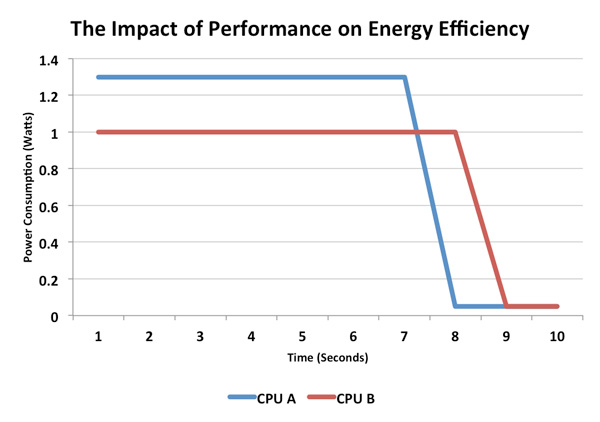
Despite being faster, the 1.3W CPU isn't fast enough to overcome the 30% increase in power. Here CPU A does 9.25J of work vs. 8.1J for CPU B. Perhaps the faster CPU has more cores and the workload isn't well threaded, or maybe the workload is more optimized for the slower architecture, regardless of the reason this is just as valid of a scenario.
Albeit overly simplified, these two cases are examples of what could happen between the iPhone 4 and iPhone 4S. ARM hasn't published a lot of data comparing the Cortex A8 to A9, but ARM has publicly stated that a single A9 core can consume 10 - 20% more power than a single A8 core. If we assume those numbers are under max load, then the A9 simply needs to be more than 10 - 20% faster than the A8 in order to come out ahead. As we've already seen from some of our benchmarks, that's not too difficult, particularly in web browsing. But in other tests, the advantage is more marginal.
The comparison becomes more complex when you take into account there are two Cortex A9s in Apple's A5 SoC vs. a single Cortex A8 in Apple's A4. This is potentially an advantage as a well threaded app could run both cores at a lower voltage/frequency combination (reducing power at an exponential level) while the single core would have to run at its maximum voltage/frequency levels.
It's also possible than two cores would consume more power, but for that to happen you'd have to be running a heavily threaded app at full frequency for a considerable amount of time. To date I haven't seen many smartphone apps that would create such a scenario, but it's akin to looping Cinebench on a quad-core vs. a dual-core part and noting a reduction in battery life for the quad-core CPU. Although the former is quicker to complete the task, the fact that you're looping it indefinitely prevents its speed from ever being an advantage for battery life.
I crudely measured power consumption on the iPhone 4 and 4S (both on AT&T) doing a variety of tasks. The granularity of my measurements is what makes them crude, I was limited to a resolution of 0.1W. While this data would've been far more useful given 0.01W resolution, we are able to use it to get a general idea of power consumption between these two phones. I briefly contemplating inserting a multimeter in-line with the battery however I chickened out, not wanting to risk damage to my phone or review device. I highlighted the obvious power advantages although keep in mind some of these advantages may be smaller (or larger) than they appear due to the 0.1W resolution of my measurements:
| Power Consumption Comparison | ||||
| Apple iPhone 4 (AT&T) | Apple iPhone 4S (AT&T) | |||
| Idle | 0.7W | 0.7W | ||
| Launch Safari | 0.9W | 0.9W | ||
| Load AnandTech.com | 1.0W | 1.1W | ||
| Maps (Determine Current Location via GPS/WiFi) | 1.3W | 1.4W | ||
Power at idle and during application launches was pretty much unchanged between the two devices, which is to be expected. The 4S did draw measurably more power loading web pages. As we've already seen however, the average performance gain in our web page loading tests was over 30%, easily making up for the increase in power draw here. Maps however pulled more power on the 4S.
What does all of this mean? The iPhone 4S has the potential to have slightly better, equal or much worse battery life than the iPhone 4. It really depends on your workload. If you're mostly browsing the web, the 4S should be about equal to if not slightly better than the 4. Our numbers seem to back that up:
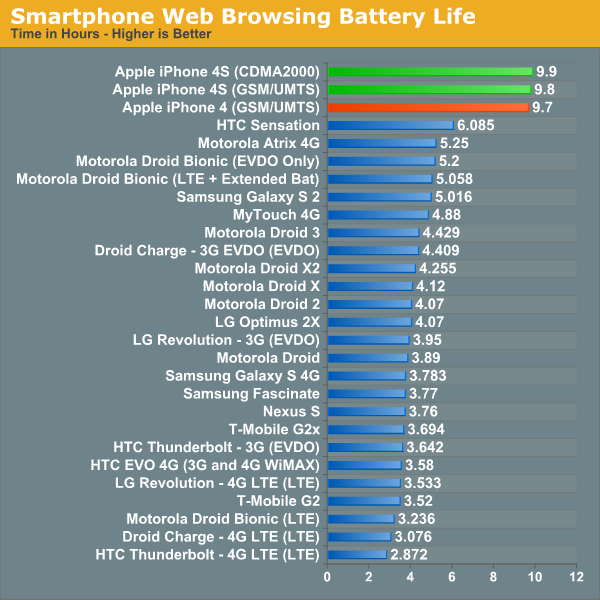
Even though the 3G results are skewed by an unrealistic amount of caching, the CPU still has to work to render and display each page. Since the workload remains the same between the iPhone 4 and 4S, the latter simply enjoys a performance improvement (pages load quicker) while extending battery life a bit thanks to being asleep for longer.
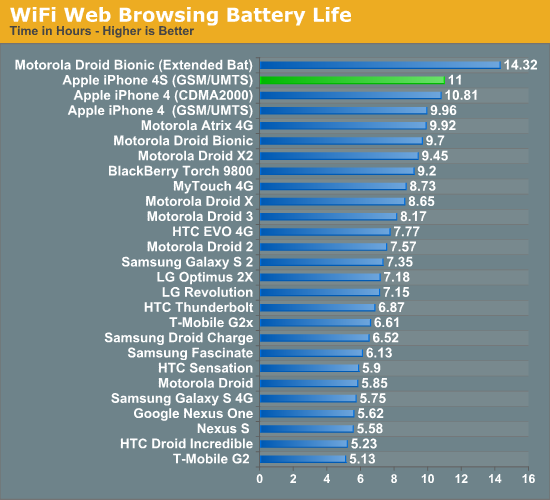
There is one caveat to web browsing battery life: the 4S will only last longer if you do the same amount of work on it. Typically, if web pages load quicker, you end up browsing more on the faster device than you would on the slower device. If you do browse more on the 4S as a result of its speed improvements, battery life won't be as good as it was on the 4. There's nothing you can do about this - faster CPUs and faster Internet connections have always encouraged faster browsing, but it's something to keep in mind if you make the upgrade.
3D Gaming Battery Life
| Power Consumption Comparison | ||||
| Apple iPhone 4 (AT&T) | Apple iPhone 4S (AT&T) | |||
| Launch Infinity Blade | 2.2W | 2.6W | ||
| Infinity Blade (Opening Scene, Steady State) | 2.0W | 2.2W | ||
Infinity Blade is a GPU intensive 3D game, which obviously causes the GPU transistors to fire up on both SoCs. Given the beefier GPU in the 4S, much higher power consumption here isn't unexpected. Since battery capacities haven't really changed, and the 4S does draw significantly more power under heavy GPU load (even limited by Vsync), you can expect lower battery life when running GPU intensive 3D games. To put some real world numbers to the data I ran a loop of Epic's Citadel demo on both the 4 and 4S until both phones died:
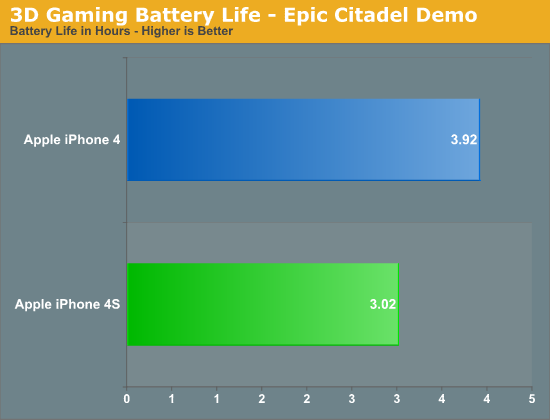
The iPhone 4 lasted around 30% longer in our GPU test compared to the iPhone 4S. This is actually a trend we have seen before, with the move to the 3GS we noted a similar impact on battery life compared to the previous iPhone 3G. If you're going to do any heavy 3D gaming, expect the iPhone 4S to burn through your battery quicker - although you will have a better experience on the 4S thanks to a smoother frame rate. Note that for sufficiently light 3D workloads (e.g. where the iPhone 4 is already bumping into Vsync), it's unlikely that you'll see much of a difference in battery life between the two phones. Citadel is simply too strenuous of a test for the 4. What really penalizes the 4S is its ability to run at nearly 2x the frame rate of the 4.
| Power Consumption Comparison | ||||
| Apple iPhone 4 (AT&T) | Apple iPhone 4S (AT&T) | |||
| Launch iBooks | 1.3W | 1.2W | ||
| iBooks Page Turning Animation (Rapid Movement) | 1.6W | 1.5W | ||
If you're concerned that GPU acceleration throughout the OS will penalize the 4S, I wouldn't be too worried. The data above shows power consumption while running iBooks. For the second test I took a book page and quickly moved it left/right to trigger the ever impressive page turning animation. Doing so drove power consumption up, but the 4S consistently pulled less power than the iPhone 4. If you're going to be at the forefront of 3D gaming on iOS, the 4S won't last as long as its predecessor. For casual use, you should be just fine.
3G/WiFi Battery Life
I ran several speedtests in the same location on both 3G and WiFi to see if I could get a clear idea of whether or not the baseband and WiFi stack in the 4S was more power efficient than in the 4. The results unanimously agree, the 4S is more power efficient at uploading/downloading at the limits of 3G and WiFi:
| Power Consumption Comparison | ||||
| Apple iPhone 4 (AT&T) | Apple iPhone 4S (AT&T) | |||
| Speed Test (3G, Downstream) | 2.8W | 2.4W | ||
| Speed Test (3G, Upstream) | 3.0W | 2.8W | ||
| Speed Test (WiFi, Downstream) | 1.5W | 1.4W | ||
| Speed Test (WiFi, Upstream) | 1.6W | 1.4W | ||
Our tethered test gives us a good idea of how quickly the 4S will die under moderate cellular data load. Apple's power advantages under iOS are due to wonderful management of idle time, similar to what we've seen with OS X vs. Windows 7. Under load however, Apple is bound by the same physical realities as its competitors and the question of battery life becomes one of battery capacity divided by peak power draw. Here the iPhone 4S does very well, but it's outpaced by the upper echeleon of Android phones:
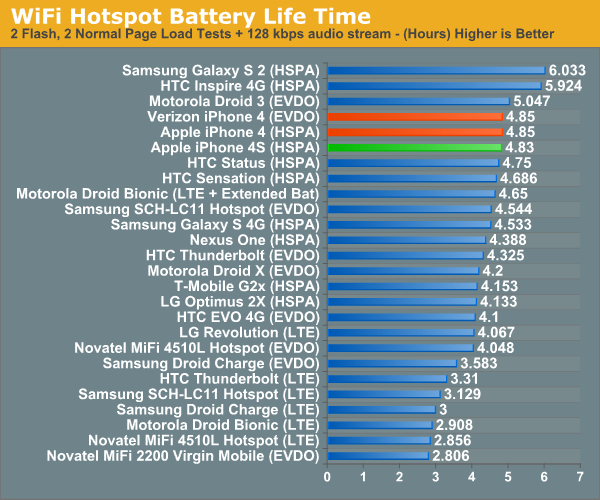
It is surprising that despite the peak power advantages above, we didn't see any improvement in our WiFi hotspot test. The only explanation I have is that the power advantage may not be as pronounced if we're not pushing the limits of the wireless interfaces.
Call time, on the other hand, improves tangibly compared to the iPhone 4. As the screen is off and the CPU mostly idle during this test, it really just echoes the numbers we saw above. Qualcomm's MDM6610 seems to outclass the outgoing Infineon X-Gold baseband when it comes to power efficiency:
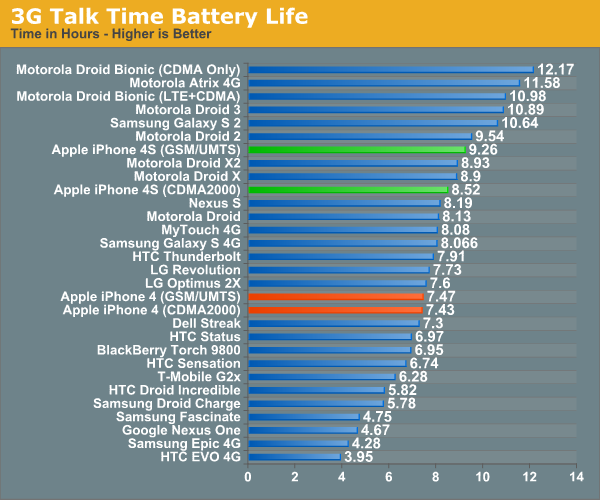
Based on the data we have here, I'd say Apple's claim of 8 hours of battery life is fairly realistic under some sort of continuous use/load. If you're constantly pulling data don't expect to see more than 5 hours, but if you're mostly reading/watching/consuming content you will get closer to 10 hours on the iPhone 4S. Call time falls at the longer end of the spectrum, but be warned: run a demanding 3D title and you'll see barely over 3 hours of use out of the iPhone 4S. It looks like any serious 3D gaming is going to have to be tethered or at least near a power outlet. The move to 28/32nm should buy us some more power headroom, but then again there are even faster GPUs just around the corner.
Based on our data, concerns about the iPhone 4S' battery life seem unrelated to hardware. The raw power consumption numbers show a platform that's competitive with its predecessor in most areas, only really hurting when it comes to heavy 3D workloads. If you're seeing worse battery life on the 4S, the cause would appear to be software related. Wipe, setup from scratch (no restore), remove/re-add all accounts and reset network settings would be the best course of action if you're seeing higher than normal power consumption.
Moving forward, I wouldn't be too surprised to see battery life remain around this level for the near future without significant advancements in battery or process technology. As we look toward the next-generation of microprocessor architectures, they simply become more robust out-of-order designs. As we've learned from the move to multi-core on the PC side however, continued gains in single threaded performance become increasingly difficult to come by - particularly without expending a lot of energy. There is hope for an increase in efficiency via heterogeneous multiprocessing, but just how much that will buy us remains to be seen. Process technology and architecture are going to become even more important over the coming years in the mobile space.










199 Comments
View All Comments
Formul - Monday, October 31, 2011 - link
There is about a dozen fairly similar android phones every month. As iPhone gets refreshed just once every year (this time year and a half) and has bigger market than any single android phone out there it makes sense to make the review thorough. I guess Nexus Prime and even Razer will get similar lengthy reviewsa ... as did many other android phones before that (galaxy s2 for example had about the same as this one).You are the one biased here. Counting the number of android articles on any gadget blog will seriously outpace the iPhone by far. You should shut up and read what you want, no one is forcing you to read this blog or any particular article on it. I dont read android articles, i dont care about android all that much. Why do you have to troll here if it does not interest you after all?
Anand Lal Shimpi - Monday, October 31, 2011 - link
I believe we did just that for the Galaxy S 2 review:http://www.anandtech.com/show/4686/samsung-galaxy-...
We don't have the RAZR, Galaxy Nexus or S2 Skyrocket, but we typically do a deep dive whenever there's a new platform transition or something truly unique to look at.
Take care,
Anand
LordSojar - Tuesday, November 1, 2011 - link
Hmm, touche Anand, I had forgotten about how detailed the S2 review was.The RAZR doesn't warrant a particularly detailed review I suppose, but I think the S2 Skyrocket might warrant a detailed antenna review etc considering the transition to LTE along with, what should be a major change to the antenna and should (I think) have QC's MDM9615 or MDM8215 chips in it... which is a big deal considering those could yield not only significant speed gains along with an antenna update, but some major throughput.
Cheers
doobydoo - Tuesday, November 1, 2011 - link
'Samsung releases a new phone that has overall better features, faster CPU, faster NAND, a different and arguably better (or at least equal) screen'I hope you are comparing to the OLD Samsung, in this sentence, rather than comparing to the iPhone 4S.
The CPU/GPU performance of the iPhone 4S is not comparable to the Galaxy S2, and I would argue the features are very much superior too.
Which, incidentally, along with the dual-antenna design, Siri, brand new camera, makes the iPhone 4S much more of a step up than the Samsung Galaxy to Samsung Galaxy S2. (The Galaxy S was about the same performance as the iPhone 4. The Galaxy S2 is slower than the iPhone 4S, therefore iPhone 4S is a bigger upgrade).
And of course, as Anand said, they thoroughly review most phones, and as the other poster says, the Android phones come out way more often so over the same length of time they get at least as much if not more coverage.
Tetracycloide - Tuesday, November 1, 2011 - link
The Galaxy S2 released in May. The 4S released in October. The next Galaxy phone, the generation the 4S is actually going to compete with, is the Galaxy Nexus. What I'm saying is your point would hold more water (or any at all) if Samsung didn't make 2 upgrades in the space of time it took Apple to do 1 so the differential between generations is hardly an apples to apples comparison (pun intended).thunng8 - Tuesday, November 1, 2011 - link
But the Galaxy Nexus isn't any faster than the S2. The main benefit is the new operating system and higher resolution screen.The Nexus is actually a significant step backwards from the S2 in terms of camera (likely from the samples on the prototype) and GPU (definitely since it is using the SGX540) performance
doobydoo - Wednesday, November 2, 2011 - link
Release dates will not stop phone users comparing the iPhone 4S to the Androids released in March 2012, just like they compared all the Androids over the last 17 months to the iPhone 4.The iPhone 4S, right now, is competing with the Galaxy S2 directly.
The Nexus Prime, as the other comment alluded to, is a significant downgrade from the Samsung Galaxy S2. Indeed, it uses the same GPU as used in the much older Samsung Galaxy S (albeit clocked higher).
The Galaxy S to S2 took approximately a year inbetween generations (June 2010 to May 2011), which is very much in line with the typical Apple release cycle of annually (this year was the exception). Even this year, with the extended timeline between iPhone 4 and 4S, Samsung didn't make 2 upgrades during that time. Your point would hold more water (or any at all) if it had.
Tetracycloide - Wednesday, November 2, 2011 - link
It's obvious you're not making a real comparison between current products but instead of admitting that you pretend it's a non-issue and then strangely fought that issue anyway by suggesting I'm not actually right to call you out on these shenanigans. So thanks for being obtuse about this, it makes it much easier to dismiss your position as that of an irrational fan-boy (at least it does when combined with the condescension in some of the other threads you've commented on here).doobydoo - Friday, December 2, 2011 - link
'It's obvious you're not making a real comparison between current products'Erm, huh?
That's EXACTLY what I'm doing.
What YOU'RE doing is asking is to compare a phone which isn't even out yet with a phone which is. You're trying to 'pretend it's a non-issue' that the phone you say the iPhone 4S should be compared with wasn't even out when this discussion started. THAT is the definition of fanboy-ism. It's like the constant like of Android fans 'x WILL be better when it eventually comes out' - and THAT is obtuse.
So, the only comments which can be dismissed are YOUR fanboy comments about 'x phone released in x months will be better'. Turns out you were wrong anyway, but that's irrelevant - the bottom line is you don't want iPhone to be compared to CURRENT Android phones, but instead compared to FUTURE ones.
Rational, much?
As it happens, it's out now, and isn't even much of an improvement on the Samsung Galaxy S2
Lucian Armasu - Wednesday, November 2, 2011 - link
The cameras seem to be about the same, according to Anand. I've actually found the SGS II camera to be a bit better in photo comparisons. Siri? I still think it's more of a gimmick for now. Maybe in 5-10 years it will be actually useful. Once the novelty expires, people will barely even use it in a few months. The same happened with FaceTime which everyone went crazy about at launch, and then they stopped using it completely.The CPU of the SGS2 IS faster than iPhone 4S CPU. There's no way Apple managed to get a 50% performance improvement for the same Cortex A9 chip that Samsung is using.
I think Anand can confirm this. He wasn't very clear in the review. He was only talking about the improvements it gets over the old Cortex A8.